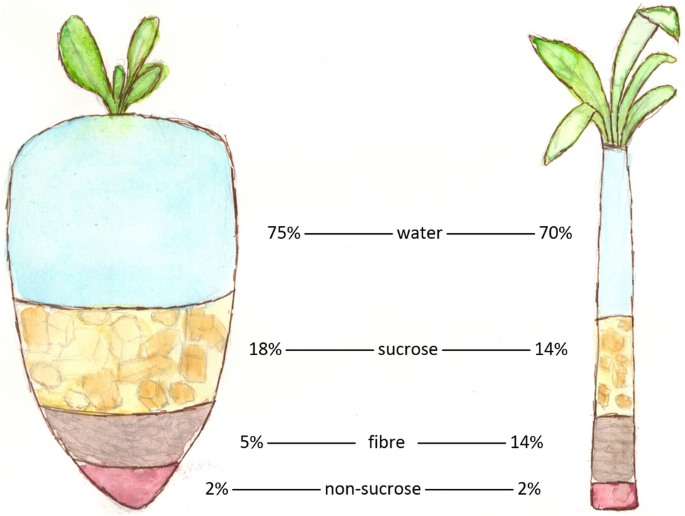Discover the Uses and Benefits of Beet Sugar Vs Cane Sugar in Your Daily Diet
Exploring the distinctive high qualities of beet and cane sugar discloses even more than simply their sweetening abilities; it highlights their unique impacts on health and wellness and cooking arts. Beet sugar, known for its subtle taste, is commonly preferred in fragile treats, whereas cane sugar, with its tip of molasses, includes richness to durable meals. Each kind holds its very own nutritional account and glycemic implications, welcoming a much deeper understanding of their roles in a well balanced diet plan and lasting consumption techniques.
Beginning and Manufacturing Procedures of Beet and Cane Sugar

The distinctive climates and dirt kinds required for growing sugar beetroots and sugarcane contribute to distinctions in their farming methods and geographic distribution, influencing the economics and sustainability of their production. beet sugar vs cane sugar.
Nutritional Comparison Between Beet Sugar and Cane Sugar
In spite of originating from various plants, beet sugar and cane sugar are nutritionally very comparable, both primarily consisting of sucrose. Each supplies concerning 4 calories per gram, translating to approximately 16 calories per teaspoon. Structurally, both sugars are composed of about 99.95% sucrose, with very little amounts of other materials like moisture and trace element, which do not significantly change their nutritional profiles.

Ultimately, when picking between beet sugar and cane sugar based on nutritional web content alone, both deal identical benefits and downsides as they are basically forms of the exact same particle-- sucrose, offering quick power without other nutrients.
Impact on Wellness: Glycemic Index and Caloric Material
Checking out even more into the results of beet sugar and cane sugar on health and wellness, it is very important to consider their glycemic index and calorie material. Both sugars are classified as sucrose, which is composed of glucose and fructose. This structure leads them to have a comparable influence on blood glucose degrees. The glycemic index (GI) of both beet and cane sugar is around 65, classifying them as high-GI foods, which article source can trigger fast spikes in blood sugar levels. This is an important element for individuals handling diabetic issues or those trying to stabilize their power degrees throughout the day.
Each kind of sugar includes about 4 calories per gram, making their caloric content equivalent. For those checking caloric intake, specifically when handling weight or metabolic health and wellness problems, recognizing this equivalence is important (beet sugar vs cane sugar). Excessive intake of any high-calorie, high-GI food can add to health and wellness concerns such as excessive weight, heart illness, and insulin resistance.
Environmental and Economic Considerations of Sugar Production
Beyond health influences, the manufacturing of beet and cane sugar also elevates substantial environmental and financial problems. Sugar beet cultivation tends to require cooler environments and has a reduced geographical impact contrasted to sugar cane, which flourishes in tropical regions. However, both plants are extensive in terms of water usage and land occupation, possibly resulting in logging and water deficiency. Economically, the global sugar market is highly volatile, affected by adjustments in worldwide profession policies and aids. Several countries incentivize sugar production via financial backing, skewing market prices and impacting small farmers adversely.
In addition, making use of pesticides and fertilizers in both beet and cane sugar farming can bring about dirt destruction and pollution, further affecting biodiversity and regional water bodies (beet sugar vs cane sugar). The selection in between growing sugar beet or cane typically hinges on neighborhood ecological conditions and economic factors, making the sustainability of sugar production a complicated concern
Culinary Applications and Taste Differences
While navigate here the ecological and financial elements of sugar manufacturing are indeed significant, the choice between beet and cane sugar also influences culinary applications and taste accounts. Beet sugar, derived from the sugar beet plant, is understood for its remarkably neutral taste.
Walking stick sugar, removed from sugarcane, often keeps molasses traces, which impart a distinctive splendor and deepness. The minor variation in dampness material in between beet and cane sugar can influence the texture and consistency of meals, making cane sugar a favored selection for details recipes that benefit from its special homes.

Verdict
In final thought, both beet and cane sugar have unique origins and manufacturing procedures, providing comparable nutritional profiles with slight distinctions in salt material and taste. While their effect on health and wellness, specifically concerning glycemic index and calories, is comparable, the option in between them typically comes down to ecological, economic variables, and certain culinary needs. Comprehending these facets can guide customers in making informed decisions that straighten with their health and wellness goals and flavor choices.